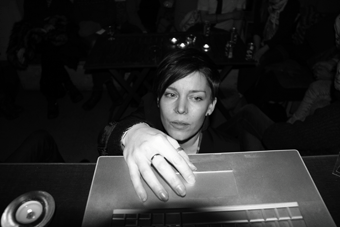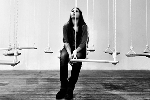 |
||||||||||||||||||||||||||||||||||||||||||||||||||||||||||||||||||||||||||||||||||||||||||||||||
I STILL HAVE AN OTHER-ACHE |
||||||||||||||||||||||||||||||||||||||||||||||||||||||||||||||||||||||||||||||||||||||||||||||||
| Sound installation A four channel thematized vocal composition build by layers upon layers of orchestrated melodies and lyrics, surrounding potentially colliding swings. Material: speaker system and computer with external sound card, wooden swings, chains Sound format: 4 channels, 2 parallel stereo tracks Duration: 5 min (including silence) loop Composition, lyrics, song and recordings made by Emma-Lina Ericson Audio mastering made by A&O Recording Studios Year: 2013 |
||||||||||||||||||||||||||||||||||||||||||||||||||||||||||||||||||||||||||||||||||||||||||||||||
The piece was shown for the first time during the solo exhibition "Jag har fortfarande ont i min älskade" at Candyland in Stockholm, 2013 I Still Have an Other-Ache - The Bereft was shown at "SENSE OF LOSS - en bråddjup utställning om sorg" at Studio 44, in Stockholm 2014 and during the art-festival Survival Kit Umeå, Umeå 2014 The version with two swing, called Face to Face was also part of Living Archive Stockholm Edition: Dada Polis curated by Red Min(e)d at c.off, Stockhom 2014 |
||||||||||||||||||||||||||||||||||||||||||||||||||||||||||||||||||||||||||||||||||||||||||||||||
| Excerpt from I still have an Other-ache, stereo version |
||||||||||||||||||||||||||||||||||||||||||||||||||||||||||||||||||||||||||||||||||||||||||||||||
ABOUT |
||||||||||||||||||||||||||||||||||||||||||||||||||||||||||||||||||||||||||||||||||||||||||||||||
| In the sound installation “I Still Have an Other-ache” it’s the kindred’s voices that one hears: thoughts occupying families and friends. Based on peoples testimonies and stories found on blogs, forums and in conversations I've composed an evocative musical orchestration; a lyrical collage of quotations, reflections and re-emerging questions circulating the mind of people struck by a particular, sever and complex loss. As the title suggests the piece like to draw attention to a particular form of compassion. In Roland Barthes book A Lover’s Discourse there is a chapter with the heading I Have an Other-Ache where Barthes writes about the "healthy" civilized and artistic form of compassion: "So I shall suffer with the other, but without pressure, without losing myself." |
||||||||||||||||||||||||||||||||||||||||||||||||||||||||||||||||||||||||||||||||||||||||||||||||
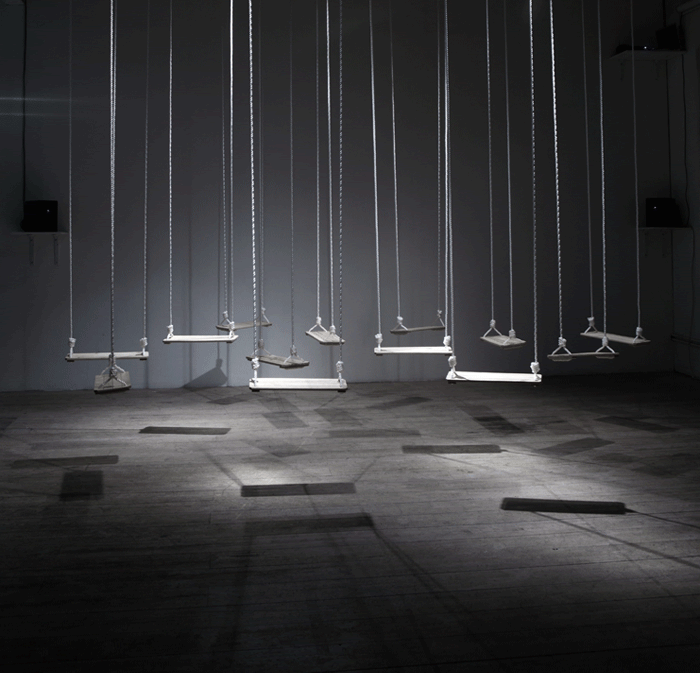 |
||||||||||||||||||||||||||||||||||||||||||||||||||||||||||||||||||||||||||||||||||||||||||||||||
| I Still Have an Other-Ache - The Bereft Installation view at "SENSE OF LOSS - en bråddjup utställning om sorg", Studio 44, 2014 Photo: Bea Tigerhjälm |
||||||||||||||||||||||||||||||||||||||||||||||||||||||||||||||||||||||||||||||||||||||||||||||||
| BACKGROUND |
||||||||||||||||||||||||||||||||||||||||||||||||||||||||||||||||||||||||||||||||||||||||||||||||
| What happens to us when someone we love is unhappy or doesn’t have the strength to live anymore? How are children, siblings, parents and friends affected when a loved one has a psychological accident and disappears, instead of staying with those left behind? It is not an easy topic to talk about. Should we even talk about it? Some people say talking about it just endanger others following in the same footstep. I always believed silence is a bigger threat. Every year 10 000 to 15 000 people in Sweden are struck by difficult and complex grief because a person dear to them commits suicide. These people often struggle with more than just complex grief - researchers have finally found evidence showing that in the long run many of these people risk developing criminal behaviour, physical and mental illness. This is old knowledge but maybe we can look forward to a better, more holistic way of approaching and treating depression and suicidal behaviour thanks to it. I grew up with a mother who struggled with periods of depression, self-inflicting behaviours and suicide attempts from early adolescent. Naturally this affected people around her. I suspected from an early age she were to die in a certain way. I developed a highly over-responsibly kind of worry, a sixth sense for her and other peoples state of mind, anxiety, a growing sense of insufficiency, powerlessness and insight that wholehearted-ness is the most important thing in life. 2005 she once again tried to leave, and this time she went. I like to think that my family and me prolonged her life, that we helped her fill it with value and love. Still I carry an undefined kind of unease. I host traces of an excruciating betrayal. I find it crucial to dissolve anxiety, shame, guilt and fear; I practice my resistance every day. How can we talk about pain and depression, suicide and worry for a loved one? Are these topics only to be ventilated behind closed doors of therapists and isolated families? What can we learn about our selves and our society through knowledge gained through these kinds of experiences? The art piece I still have an Other-ache is developed to give the overall matter; peoples love, pain and knowledge emerged from these mental battles and social relations; within the own self and between fellow man, an open, common and public space for introspection, reflection and shared discussions. |
||||||||||||||||||||||||||||||||||||||||||||||||||||||||||||||||||||||||||||||||||||||||||||||||
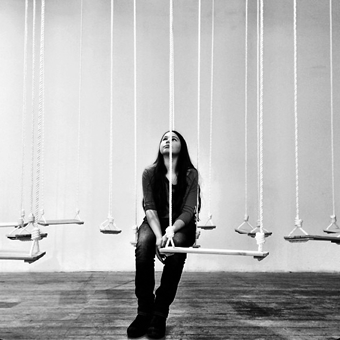 |
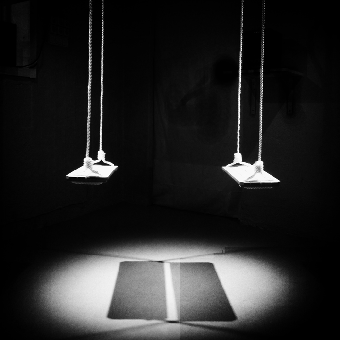 |
|||||||||||||||||||||||||||||||||||||||||||||||||||||||||||||||||||||||||||||||||||||||||||||||
| Installation view at SENSE OF LOSS - en bråddjup utställning om sorg, Studio 44, 2014 Photo: James Foote |
I Still Have an Other-Ache - Face to Face Installation view, Living Archive StockHolm Edition: Dada Polis, c.off/ccap |
|||||||||||||||||||||||||||||||||||||||||||||||||||||||||||||||||||||||||||||||||||||||||||||||
INSTALLATION CONCEPT |
||||||||||||||||||||||||||||||||||||||||||||||||||||||||||||||||||||||||||||||||||||||||||||||||
| In my art I include the viewer or visitor, as I prefer to call they who encounter my installations. I do this early on in the process. I want to include the body, its senses and skill to comprehend things the mind avoids. Many times I think about it as if I am building a stage or a scene for the visitor. Simply by entering the visitor thereby also becomes a performer. The pace of “I Still Have an Other-ache” correlates with the pace of a swaying swing or waves approaching the shore. I find similarities between how swings places bodies in a levitated, pending position and how a suicide raises questions without answers. I believe the body can place and replace the mind; the mind has power to seduce, reduce and re-store the body. A swing is easily associated with children, childhood, innocence, a sense of freedom and play. An empty swing can attract, it can also suggest absence: absence of childhood, innocence, a sense of freedom and play. With facing, potentially colliding swings the piece want to engage the visitor in a playful possibility to sit, place a thought of the child and the visitors ears at the sound installations centre point. Our actions and move about affect others; we are always connected, also if The Other is absent. Your comprehension shifts with your position. You can bump in to a stranger and find ways to be and move side by side and together, initiate intimate conversations or silently chare a moment. The number of swings in the installation differs depending on where it is shown. To bring the affect suicide have on next of kin to the fore - I develop the physical appearance of I still have an Other-ache to reflect statistics from the region where it is shown. So far two different versions has been shown; "The Bereft" and "Face to Face" The Bereft includes 13 swings and gives an estimated picture and physical experience of how many peoples life are severely affected by every single suicide. Face to Face include two swings and focuses on facing the loss. |
||||||||||||||||||||||||||||||||||||||||||||||||||||||||||||||||||||||||||||||||||||||||||||||||
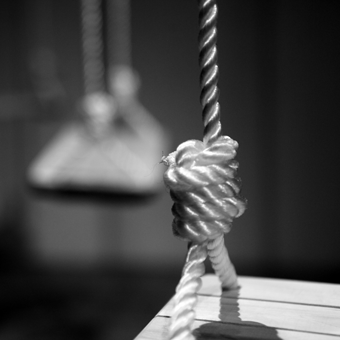 |
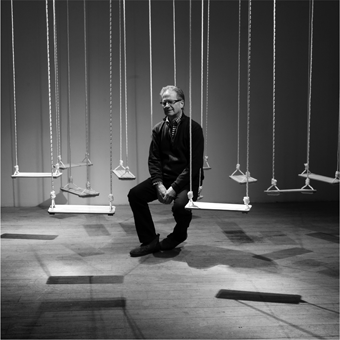 |
|||||||||||||||||||||||||||||||||||||||||||||||||||||||||||||||||||||||||||||||||||||||||||||||
| Detail of swing Photo: Bea Tigerhjälm |
During "SENSE OF LOSS - en bråddjup utställning om sorg" at Studio 44, 2014. Photo: Bea Tigerhjälm |
|||||||||||||||||||||||||||||||||||||||||||||||||||||||||||||||||||||||||||||||||||||||||||||||
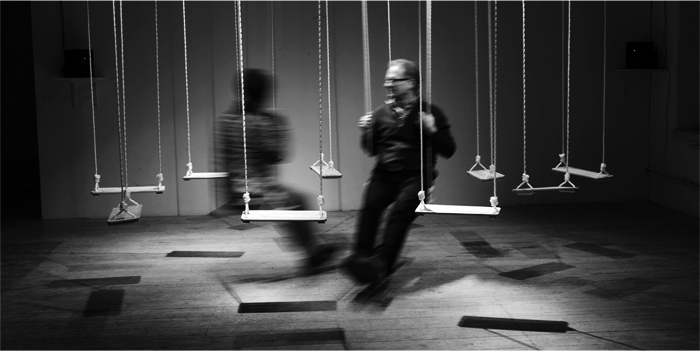 |
||||||||||||||||||||||||||||||||||||||||||||||||||||||||||||||||||||||||||||||||||||||||||||||||
| During "SENSE OF LOSS - en bråddjup utställning om sorg" at Studio 44, 2014 Photo: Bea Tigerhjälm |
||||||||||||||||||||||||||||||||||||||||||||||||||||||||||||||||||||||||||||||||||||||||||||||||
 |
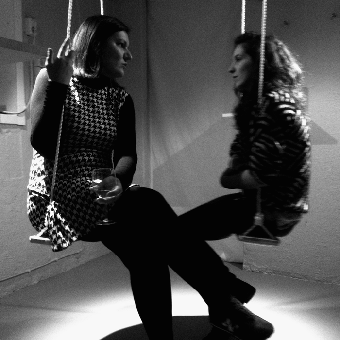 |
|||||||||||||||||||||||||||||||||||||||||||||||||||||||||||||||||||||||||||||||||||||||||||||||
| View from the street during Survival Kit Festival in Umeå, 2014 Photo: Fanny Carinasdotter |
During "Living Archive StockHolm Edition: Dada Polis" at c.off/ccap, 2014 Photo: Elin Magnusson |
|||||||||||||||||||||||||||||||||||||||||||||||||||||||||||||||||||||||||||||||||||||||||||||||
VOCAL COMPOSITION CONCEPT |
||||||||||||||||||||||||||||||||||||||||||||||||||||||||||||||||||||||||||||||||||||||||||||||||
| The sound picture; the voice composition consisting of layers upon layers of one single singers voice multiplied, initially emerges from my relation with my own diversity or manifold and at some periods disunity within. I find a humours and soothing liberation with the intellectual experiment that a person, a psych contains "a society of diverse inhabitants". One is not only one; one is several. You listen to and manifest your various and sometimes conflicting inhabitant's thoughts (voices), affects, reactions and actions differently depending on who your inhabitants are, what they have learned to draw on, and how You as the performer conduct them/your self(s). I’ve use this hypothesis to investigate bigger scenarios: I apply it on conflict-ridden interpersonal phenomena in our society; I forcibly personalize opposite ideas by squeezing them together, breaking them apart and enrolling them, placing them inside and letting them play different parts within one and the same human psych. It’s a game of scales and space. It’s a search for new knowledge. It’s a manifested need to seek understanding, acceptance, and a propitious approach to divisiveness and chaos. The challenge is to find ways where the manifold, without loosing its different subject’s respective personality or vitality, together can form a parallel and harmonized coexistence; a shared external body. I find a useful formula in how music is organised. Orchestration, especially polyphonic compositions I think succeed. In my vocal sound pieces the musical composition play the part of the united body. The body consist of its inhabitants; different characters that speak (sing) there diverted minds. I look for a musical form, pace and colour that correlates to the overall theme. I try to find rhythm, dynamic and melody to mirror each character. By shooting a kaleidoscopic mass of parallel information on the visitor she has to choose how to listen. The act of subjectively understanding is acutely highlighted. What you draw on differs. You listen, read and rewrite the world around you. Your experience differs from others. I want to encourage listening, exchange of experiences and re-listening, to your own inner voices and to your fellow human being. |
||||||||||||||||||||||||||||||||||||||||||||||||||||||||||||||||||||||||||||||||||||||||||||||||
 |
||||||||||||||||||||||||||||||||||||||||||||||||||||||||||||||||||||||||||||||||||||||||||||||||
| Installation view at Candyland, 2013 Photo: Elin Gunnarsson |
||||||||||||||||||||||||||||||||||||||||||||||||||||||||||||||||||||||||||||||||||||||||||||||||
 |
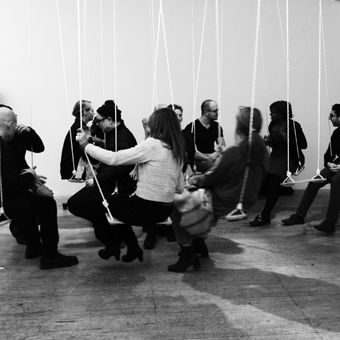 |
|||||||||||||||||||||||||||||||||||||||||||||||||||||||||||||||||||||||||||||||||||||||||||||||
| Installation view at Survival Kit Festival Umeå,
2014 Photo: Fanny Carinasdotter |
During "SENSE OF LOSS - en bråddjup utställning om sorg" at Studio 44, 2014 |
|||||||||||||||||||||||||||||||||||||||||||||||||||||||||||||||||||||||||||||||||||||||||||||||
LYRICS |
||||||||||||||||||||||||||||||||||||||||||||||||||||||||||||||||||||||||||||||||||||||||||||||||
| The lyrics in I still have an Other-ache is based on conversations and written testimonies by relatives and close friends to people whom prematurely ended their lives. On pages and forums like sjalvmordsupplysningen.se, anhoriga.ifokus.se, vsmis.dinstudio.se, alexandralundsten.blogspot.se, trosteboken.blogg.se, flashback.org/t395005, spes.se you find "survivors"; next of kin's and friends who lost a dear one in suicide sharing experiences, discussing and supporting each other in how to cope with loss and deal with life. I've used excerpts and stories from these sites in "I still have an Other-ache" The final manuscript is a collage; a web of several survivors’ diverse experiences, created through deconstruction and inversion, anonymization and orchestral reconstruction. Each musical part (Voice 1 – 5) contains elements of stories, references and quotes from different senders. Through an intricate musical composition, shattered voices and tales of desolation fuses into a polyphonic, harmonized and consolidated collective force. |
||||||||||||||||||||||||||||||||||||||||||||||||||||||||||||||||||||||||||||||||||||||||||||||||
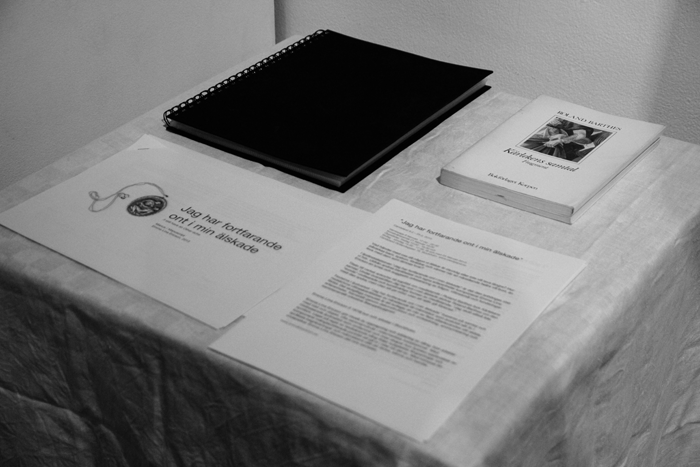 |
||||||||||||||||||||||||||||||||||||||||||||||||||||||||||||||||||||||||||||||||||||||||||||||||
| Candyland, 2013 Photo: Elin Gunnarsson |
||||||||||||||||||||||||||||||||||||||||||||||||||||||||||||||||||||||||||||||||||||||||||||||||
MANUSCRIPT |
||||||||||||||||||||||||||||||||||||||||||||||||||||||||||||||||||||||||||||||||||||||||||||||||
|
||||||||||||||||||||||||||||||||||||||||||||||||||||||||||||||||||||||||||||||||||||||||||||||||
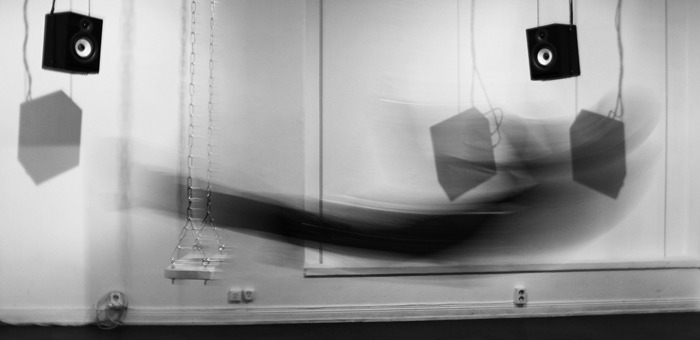
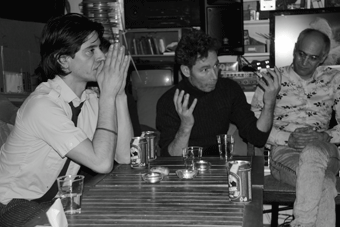 iiiiiiiii
iiiiiiiii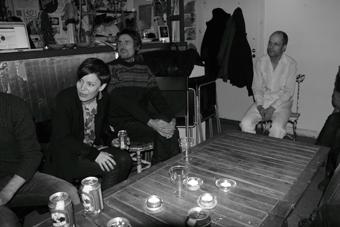
 iiiiiiiii
iiiiiiiii